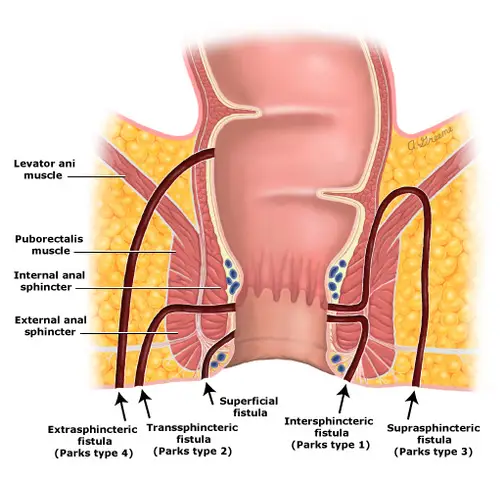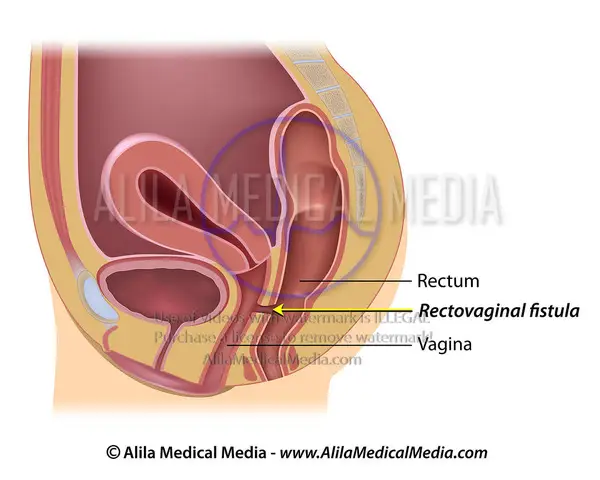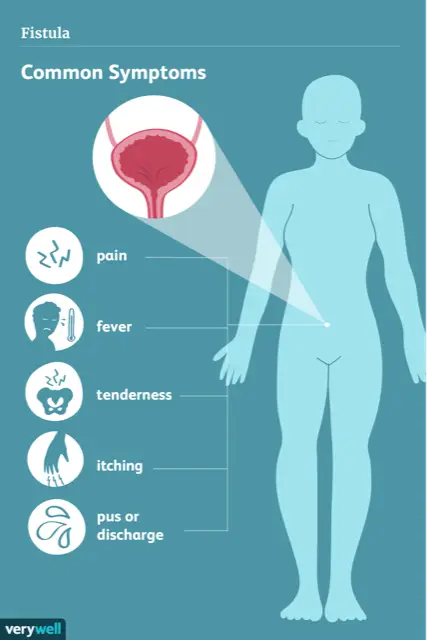Home / What is a Fistula
Fistula Definition: A fistula is an abnormal connection or passageway that connects two organs or vessels that do not usually connect. They can develop anywhere between the intestine and the skin, between the vagina and the rectum, and other places. The most common location for a fistula is around the anus.
Most fistulas are idiopathic, which just a fancy way of saying that their specific cause is uncertain. However, it’s worth noting that a significant number of them are associated with Crohn’s disease and other inflammatory conditions. In fact, about 35-50 percent of people with Crohn’s disease will develop a fistula at some point.
How Common are Fistulas?
The World Health Organization (WHO) estimates that there are 50,000-100,000 new cases of fistulas every year. In places like Africa, obstetric fistulas are often left unaddressed due to lack of obstetric care. Thankfully they’re somewhat less common in the United States, but with an estimated 200,000 cases, it’s still a significant number of people affected.
These occur when an infected gland in your anus or rectum forms a canal that leads out to the skin around the anal opening.
Rectovaginal fistulas may be caused by childbirth. Prolonged labor with necrosis of the rectovaginal septum or obstetric injury with a third- or fourth-degree perineal tear or episiotomy can lead to rectovaginal fistula. Inadequate repair, breakdown of the repair, or infection can all result in fistula development.
Like anorectal fistulas, these occur when an infection creates a passageway, only in this case, the passageway leads from the rectum or anus to the vagina.
Fistulas can occur even deeper in your digestive tract, leading from the colon to either another organ such as or bladder, vagina, or small intestine, or even reaching to the skin’s outer surface.



Most anal fistulas are the result of an infection that starts in an anal gland. The infection causes an abscess that drains on its own or is drained surgically through the skin next to the anus. This drainage tunnel remains open and connects the infected anal gland or the anal canal to a hole in the outside skin around the anus. When the abscess bursts or is surgically drained and the wound does not heal properly patients are left with a fistula.
About one in three people with Crohn’s disease will probably develop a fistula at some time and the longer you have Crohn’s disease the more likely you are to develop a fistula. Fistulas are much less common in people with ulcerative colitis (UC). This is because the inflammation in Crohn’s disease tends to penetrate the whole thickness of the bowel wall. This creates ulcers, leaks, and abscesses and as they develop a hole can start to form which then becomes a tunnel creating a fistula.
Symptoms
There is a wide range of symptoms that you may experience if you have an anal fistula, though many of these can also be symptoms of other conditions. If you have any of the following, it’s in your best interest to seek help from a medical professional: *If you’re experiencing any of these issues, be sure to promptly discuss them with a healthcare provider. Fistulas require immediate medical attention to prevent serious infections and other problems from developing.
Support System
It can be emotionally draining to remain hopeful that a treatment would produce a positive outcome especially if you had several failed surgeries and/or procedures. If you find it difficult to manage the various symptoms and their impact on your life you are not alone. It is normal to feel overwhelmed. Many people find that by talking to and finding support through family and friends helps to maintain a positive mind set. You might find that joining an on-line support group, like the Facebook group listed on the front page of this packet can really help in meeting and connecting with others that understand what you are going through
In many cases a loose or draining Seton may be used as a temporary solution prior to surgery. It may also be used longer term where prior options have proven unsuccessful. A seton is a flexible tube or thread that is placed through a fistula. The seton is a step in healing the fistula and in preventing further complications. A seton may be left in place for several weeks to several months. Regular checkups will be needed to keep an eye on the fistula and the seton.
Most of the current treatments for complex fistula are based on 3 main principles: correct identification of the fistula tracts and internal opening, complete destruction of the tracts, and the preservation of anal sphincter function. The recent surgical techniques have shown promising results as compared to traditional methods and the success rate is higher, but recurrence and incontinence remain a concern.
A simple fistula may be treated with FiLac (Fistula Laser Closure) but in the case of a complex or recurrent fistula the recommended procedure is the Distal Laser Proximal Ligation technique that was developed by Dr. Ashwin Porwal. Dr. Porwal is the founder of Healing Hands Clinic and a leading Proctologist in Pune’, India.
DLPL is a minimally invasive, sphincter saving surgery based on two principals: deep and effective debridement by laser and efficient drainage from fistula. It addresses the intersphincteric space and supralevator space which is the root cause of complex fistula.
The inter-sphincteric space is the focus of infection and needs to be addressed for complete healing of fistula without recurrence. This procedure offers the highest rate of success and the lowest rate of recurrence.
DLPL is performed with the guidance of a #D EndoAnal Imaging machine which can identify hidden fistula tracts and micro abscess in real time during surgery.
After the initial procedure, the first follow-up will be scheduled within 3-5 days with an Evaluation Under Anesthesia (EAU) scheduled between 3-5 weeks.
Copyright 2024 © All Right Reserved Design by Fistula Free
Powered by Jag Journey, LLC